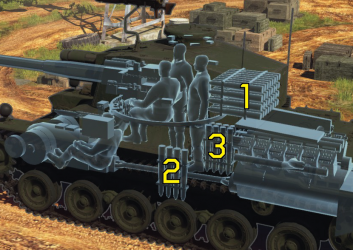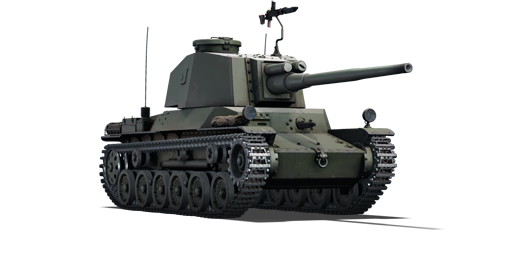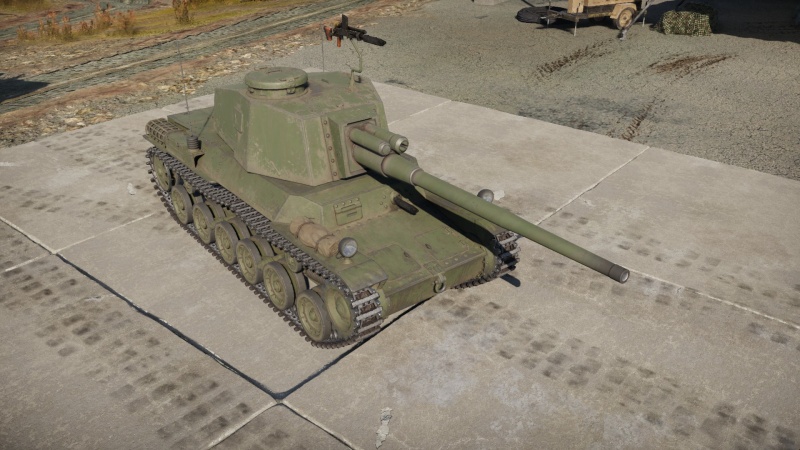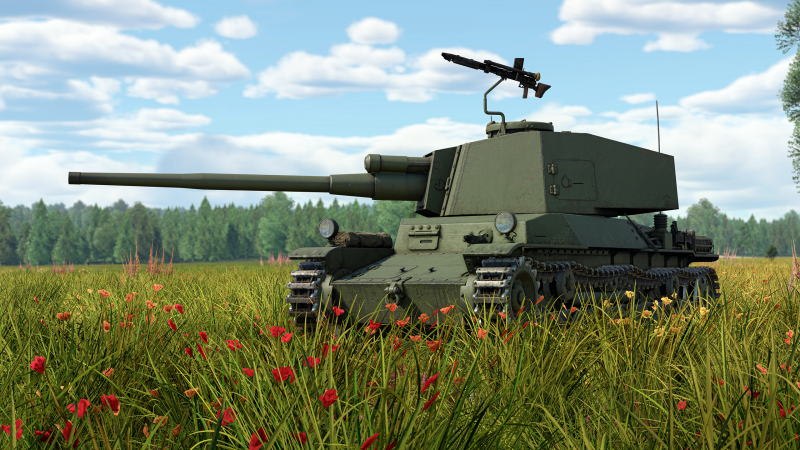Chi-Nu II
| This page is about the premium Japanese medium tank Chi-Nu II. For the regular version, see Chi-Nu. |
Contents
Description
The Chi-Nu II was one of 2 improvement plans to the Type 3 Chi-Nu, the primary goal was to up-arm the Chi-Nu with a Type 5 (75 mm) found on the Type 4 Chi-To and Type 5 Chi-Ri. The first plan was to simply mount a Chi-To turret on top of the Chi-Nu hull, which was tested at the Japanese firing range at Irago, with tests found satisfactory. The second plan was to fit the Type 5 cannon inside of a regular Chi-Nu turret.
It was introduced with the initial Japanese Ground Forces tree in Update 1.65 "Way of the Samurai", but was released once all the rank III Japanese tanks were available to the public in the Closed Beta Test. The Chi-Nu II is a combination between two vehicles, the Type 3 Chi-Nu and the Type 4 Chi-To. It has the armour of the former, but the gun of the latter. Thus, while presenting itself as a more vulnerable body with only around 50 mm of armour, it has slightly better mobility than the Chi-To, a smaller profile, yet carries the same gun. Like the Chi-To, the Chi-Nu II should be played in a sniper-like format from a distance rather than up-close to the enemy and fighting them in close-quarters.
General info
Survivability and armour
Armour type:
- Rolled homogeneous armour
| Armour | Front | Sides | Rear | Roof |
|---|---|---|---|---|
| Hull | 50 mm (15°) Front plate 12 mm (76°) Front glacis 50 mm (20°) Joint plate 8.5 mm (65°) Lower glacis |
20 mm (15-30°) Top 25 mm Bottom |
20 mm (0-20°) Top 8.5 mm (63°) Bottom |
12 mm |
| Turret | 50 mm (16°) Turret front 50 mm (10°) Gun mantlet |
25 mm (9-10°) | 25 mm | 12 mm |
| Cupola | 50 mm | 50 mm | 50 mm | 12 mm |
Notes:
- Suspension wheels are 15 mm thick while tracks are 20 mm thick.
Mobility
| Game Mode | Max Speed (km/h) | Weight (tons) | Engine power (horsepower) | Power-to-weight ratio (hp/ton) | |||
|---|---|---|---|---|---|---|---|
| Forward | Reverse | Stock | Upgraded | Stock | Upgraded | ||
| Arcade | 44 | 9 | 19.8 | 372 | 458 | 18.79 | 23.13 |
| Realistic | 39 | 8 | 212 | 240 | 10.71 | 12.12 | |
Modifications and economy
Armaments
Main armament
| 75 mm Type II Model II | Turret rotation speed (°/s) | Reloading rate (seconds) | |||||||||||
|---|---|---|---|---|---|---|---|---|---|---|---|---|---|
| Mode | Capacity | Vertical | Horizontal | Stabilizer | Stock | Upgraded | Full | Expert | Aced | Stock | Full | Expert | Aced |
| Arcade | 48 | -10°/+15° | ±180° | N/A | 15.7 | 21.7 | 26.4 | 29.2 | 31.1 | 8.45 | 7.48 | 6.89 | 6.50 |
| Realistic | 9.8 | 11.5 | 14.0 | 15.5 | 16.5 | ||||||||
Ammunition
| Penetration statistics | |||||||
|---|---|---|---|---|---|---|---|
| Ammunition | Type of warhead |
Penetration @ 0° Angle of Attack (mm) | |||||
| 10 m | 100 m | 500 m | 1,000 m | 1,500 m | 2,000 m | ||
| Type 1 APHE | APHE | 149 | 146 | 133 | 118 | 105 | 93 |
| Type 4 Kou | APHE | 151 | 148 | 137 | 124 | 112 | 101 |
| Type 90 HE | HE | 17 | 17 | 15 | 14 | 12 | 11 |
| Shell details | ||||||||||||
|---|---|---|---|---|---|---|---|---|---|---|---|---|
| Ammunition | Type of warhead |
Velocity (m/s) |
Projectile mass (kg) |
Fuse delay (m) |
Fuse sensitivity (mm) |
Explosive mass (TNT equivalent) (g) |
Ricochet | |||||
| 0% | 50% | 100% | ||||||||||
| Type 1 APHE | APHE | 865 | 6.56 | 1.3 | 15 | 84.8 | 47° | 60° | 65° | |||
| Type 4 Kou | APHE | 865 | 6.75 | 1.2 | 14 | 80.64 | 47° | 60° | 65° | |||
| Type 90 HE | HE | 830 | 6.17 | 0.2 | 0.1 | 490 | 79° | 80° | 81° | |||
Ammo racks

| Full ammo |
1st rack empty |
2nd rack empty |
3rd rack empty |
Visual discrepancy |
|---|---|---|---|---|
| 48 | 17 (+31) | 13 (+35) | 1 (+47) | No |
Note:
- Turret empty: 17 (+31) shells.
Machine guns
| 7.7 mm Type 97 | ||||
|---|---|---|---|---|
| Mount | Capacity (Belt) | Fire rate | Vertical | Horizontal |
| Pintle | 1,000 (20) | 498 | -10°/+70° | ±60° |
| Hull | 3,000 (20) | 498 | -7°/+10° | ±19° |
Usage in battles
The Chi-Nu II is one of the best bargains you can get for the price, it has a high penetrating Type 5 cannon at a lower BR of the regular tanks carrying it (Chi-To, Chi-Ri II) in a tight package of the Chi-Nu, this comes with a somewhat weaker engine (compared to the heavier Chi-To & Chi-Ri) but the pro's outweigh the con's.
One may consider the Chi-Nu II a glass cannon, and a great one at that, the armour isn't much to write home about, but it isn't paper thin either. It's a very well-rounded medium tank in playstyle and can be compared and played like a Pz.IV F2, it can destroy anything, but anything can destroy it. But unlike the Pz.IV, reload speeds are longer in exchange for a faster turret rotation.
Against the medium tanks, its simply getting the first shot off first as the 75 mm Type 5 cannon on the Chi-Nu could penetrate most through the front hull armour, with some levels of difficulty on the turret. Of course, for maximizing the Chi-Nu's own survival, attack from the sides and make sure the enemy is unaware of the Chi-Nu's presence.
The Chi-Nu II can face heavy tanks, but it will most likely be the 76 mm KV-1 series, which the 75 mm can easily punch through the front armour. The Chi-Nu II can still meet the British Churchill VII, which is impervious to the high-penetrating 75 mm from the front, so beware if caught in a frontal engagement.
Pros and cons
Pros:
- Powerful 75 mm cannon with good penetration and very low shell drop-off
- Decent gun depression enables it to snipe from ridges
- Good handling
- Above average mobility
- Narrow chassis allows access through areas inaccessible by wider tanks
Cons:
- Packed crew due to narrow chassis leads to poor survivability against all shells
- Poor armour all around, can be easily penetrated by any tank even in full downtiers
- Sluggish turret traverse
- Reload rate quite slow
History
Development
The lackluster performance of Japanese tanks in World War II called for the development of newer medium tanks in the Imperial Japanese Army. The standard tank of the time was the Type 97 Chi-Ha, which has its chassis used in many expedient models to provide a bigger gun for the Japanese inventory such as the Chi-Ha Kai, Type 1 Chi-He, Type 2 Ho-I, and Type 3 Chi-Nu. Two new sophisticated tanks were also in development, the Type 4 Chi-To and the Type 5 Chi-Ri, both fielding the powerful Type 5 75 mm gun. However, these two tanks still needed time to iron out some design bugs, time that the Japanese did not have while being stared down by the Allied powers. To get the Type 5 gun out to their forces as fast as possible, designers sought a way to get the gun onto a vehicle as fast as possible. The solution laid on the Type 3 Chi-Nu, regarded as one of Japan's best tank since its production start date in 1943.[1]
The Chi-To's prototype models had larger turrets that were different from the main production model. Instead of wasting these turrets, the Japanese decided to use them on the Chi-Nu body. In March 1945, a Chi-To prototype turret was attached onto Chi-Nu chassis #37. This upgraded Chi-Nu, along the line of the Chi-Ha's upgrade, was informally labeled the Chi-Nu Kai. The design was tested on the Irago Firing Grounds on March 19th and proved itself very satisfactory in combat roles. The final design was to equip the Chi-Nu with production model Chi-To turret to increase production levels and it was to help improve Japan's armoured forces to stand up against the Allies' might. This Chi-Nu with the production Chi-To turret was known as Chi-Nu II.[1]
War's end
Like most of the Japanese late-war tanks developed and retained in the home island for the "final defense", the modified Chi-Nu and its counterparts never saw battle against Allied armour. Japan surrendered in September 1945, effectively ending World War II. A few Chi-Nu IIs were made before the end, but they are most likely sent to the scrap yard along with most of the other Japanese equipment with their demilitarization.[1]
Media
- Skins
- Videos
See also
- Related development
External links
- [Devblog] Type 3 Chi-Nu II - Crouching Tiger
- [News] A new Japanese premium tank, the Chi-Nu II is now available for purchase
References
| Mitsubishi Heavy Industries (三菱重工業株式会社) | |
|---|---|
| Light Tanks | |
| Type 95 | Ha-Go · Ha-Go Commander |
| Medium Tanks | |
| Type 89 | I-Go Ko |
| Type 97 | Chi-Ha · Chi-Ha Kai |
| Type 1 | Chi-He · Chi-He (5th Regiment) |
| Type 3 | Chi-Nu · Chi-Nu II |
| Type 4 | Chi-To · Chi-To Late |
| Type 5 | Chi-Ri II |
| SPGs | |
| Chi-Ha Derived | Ho-Ro |
| Chi-He Derived | Ho-I |
| Chi-Ri Derived | Ho-Ri Prototype · Ho-Ri Production |
| Other | Na-To · Ro-Go Exp. |
| Captured | ␗Chi-Ha · ␗Chi-Ha Kai |
| Note | Most tank designs would be contracted by the Army Technical Bureau to Mitsubishi |
| See also | Mitsubishi Heavy Industries Ltd. (Post-War) |
| Japan medium tanks | |
|---|---|
| Type 97 | Chi-Ha · Chi-Ha Kai · Chi-Ha Kai TD · Chi-Ha Short Gun |
| Type 1 | Chi-He · Chi-He (5th Regiment) · Ho-I |
| Type 3 | Chi-Nu · Chi-Nu II |
| Type 4 | Chi-To · Chi-To Late |
| Type 5 | Chi-Ri II |
| Type 61 MBT | ST-A1* · ST-A2* · ST-A3* · Type 61 |
| Type 74 MBT | ST-B2* · Type 74 (C) · Type 74 (E) · Type 74 (F) · Type 74 (G) |
| Type 90 MBT | Type 90 · Type 90 (B) · Type 90 (B) "Fuji" |
| Type 10 MBT | TKX (P)* · TKX* · Type 10 |
| Other | Ka-Chi |
| USA | ▅M4A3 (76) W · ▅M47 |
| *Prototype | |
| Japan premium ground vehicles | |
|---|---|
| Light tanks | Ha-Go Commander · Type 16 (FPS) |
| Medium tanks | Chi-Ha Short Gun · Chi-He (5th Regiment) · Ka-Chi · Chi-Nu II · Type 74 (G) · Type 90 (B) "Fuji" |
| Heavy tanks | Ro-Go · ▅Heavy Tank No.6 |
| Tank destroyers | Ho-Ri Prototype · Type 75 MLRS |






